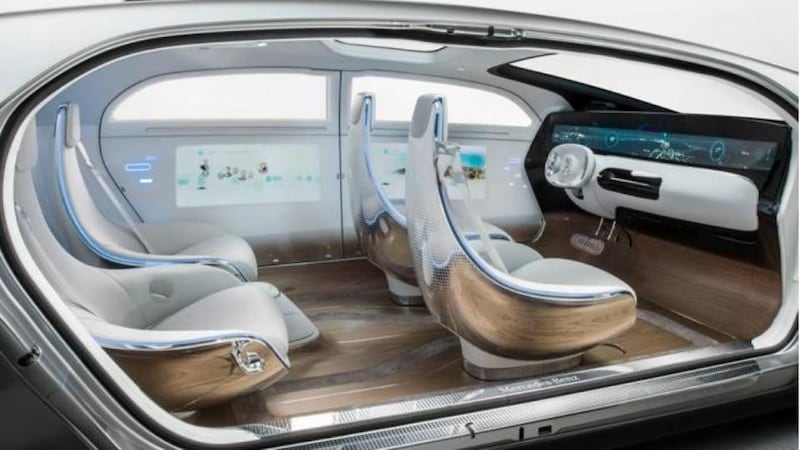Mercedes’ new autonomous driving concept, which features a lounge-like interior with facing seats, has taken the annual Consumer Electronics Show (CES) in Las Vegas by storm.
Much trailed by online videos featuring a Transformers-style robot clearly bearing Mercedes styling cues, the F015 Luxury In Motion has a cabin that spends most of its time looking akin to a first class railway carriage, with four luxurious seats facing each other, allowing the occupants to see and talk to each other while the microchips take care of the actual driving.
Whilst it is a four-door hatchback with relatively familiar proportions, the F015 is revolutionary under the skin, at least according to Mercedes. It is a pure concept, so Mercedes has allowed itself to delve into the pixie dust and wizards drawer for its drivetrain - a theoretical hydrogen fuel cell providing energy to two electric motors. Mercedes claims 282hp and 0-100kmh in 6.7secs, as well as a touring range of more than 1,000km. Then again such claims are hardly made under oath.

Made from high-strength caron-reinforced polymer, the F015 is a little lower, shorter and wider than a current S-Class but around 40 per cent lighter. Its revolutionary nature comes in the form of the battery of sensors which allow it to entirely drive itself. These, unlike the drivetrain, are relatively close to a production reality, and it even has a pedestrian detection system that not only spots when someone wants to cross the road in front of it, but even scans the environment to see if it is safe for them to do so, and then projects a digital image of a zebra crossing onto the road in front of the car while issuing an audible invitation to cross. Yes, really.
Meanwhile, inside, the cabin has been set up to provide infotainment rather than traditional driving engagement. The driver can of course control the car in the traditional sense, but all of the internal displays are screens which respond to gesture control and the steering wheel retracts fully into the dashboard when the driver decides to turn control over to the microchips. And of course there’s that swivelling seat layout, which allows all the occupants to turn and chat to one another while the car looks after itself.
So much vapourware? Perhaps not. The F015 was introduced at the CES by Mercedes' boss Dieter Zetesche who told the assembled media that "Anyone who focuses solely on the technology has not yet grasped how autonomous driving will change our society. The car is growing beyond its role as a mere means of transport and will ultimately become a mobile living space."
The F015's autonomy is also part of a major push to improve vehicle safety. Back in November, Mercedes' development chief Thomas Weber said "Autonomous driving for us is clearly part of a strategy to realise our vision of accident free driving. Most accidents happen because there is a situation that the driver can no longer can control.
Mercedes is far from alone in seeing the CES as a major exhibiting platform. As car makers, notably the likes of Volvo and Ferrari, are slowly but surely abandoning the traditional stands-and-smiles motor show model, so exhibitions like the CES are gaining in importance. What began as a show strictly for computer geeks and technology nerds has, thanks to the increasing levels of in-car electronic wizardry, become a crucial forum for car makers to show off their wares.
BMW has also taken a major stand at the CES this year, showing off an idea much closer to production reality than Mercedes' autonomous concept. It's an development of the i3 which, controlled by either a smartphone or smartwatch app, can be directed to head off and find a parking space all by itself, squeezing into and out of tighter spaces than it could with humans on board.
What sounds like a mere convenience for the driver is actually being increasingly seen as a potential social good. Audi recently told us that self-parking cars need far less space than those driven by humans, and such systems could potentially allow urban planners to reduce to volume of car parks by as much as half, without a reduction in vehicle numbers.
Renault-Nissan is also displaying its wares at CES, and its boss, Carlos Ghosn reckons that, counter-intuitively, leading edge technology can actually help buyers form a greater emotional contact with their cars. He'll have to hope he's right - an obsession with portable high-tech gadgets such as smartphones and tablets has been cited as a primary part of the falling global interest amongst 18-35-year-olds in cars.
Hyundai is also at the show, displaying its new app that allows owners to communicate, monitor and even activate their cars through a phone or watch. "This new app expands Hyundai's exploration into how wearable technology and Blue Link fit into a customer's lifestyle," said Barry Ratzlaff, executive director, customer connect and service business development, Hyundai Motor America. "Connecting to your car through a smartwatch and voice recognition was previously something seen only in science fiction movies. Now, we can provide this capability to owners of Hyundai vehicles equipped with Blue Link."
The big US car makers were also out in force with Chevrolet showing off its new Volt for the first time. The latest model of the plugin hybrid range-extender uses a new 1.5-litre petrol engine, replacing the aged 1.4-litre unit used in the first generation model. GM also claims that the battery and electric motor pack is around 100kg lighter than before as well as being 5-12 per cent more efficient, which should see the electric-only driving range extend to around 70km.










